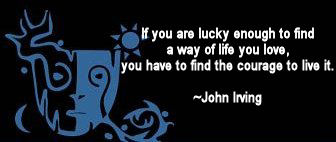|
"Open Your Eyes"
Introduction to Rethinking Adolescence:
Using Story to Navigate Life's Uncharted Years
by Jay D'Ambrosio
© 2006 Rowman & Littlefield Education, used by permission
[Image: "The Sower" by David J. Hetland, used by permission]
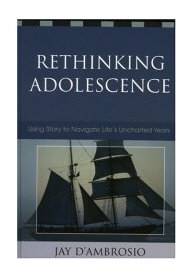
Blinding ignorance does mislead us.
O! Wretched mortals, open your eyes!
— Leonardo da Vinci
Myths are, first of all, stories: stories which confront us with something transcendent and eternal...a means by which the eternal expresses itself in time.
— Rolland Hein
So we fix our eyes not on what is seen, but on what is unseen, for what is seen is temporary, but what is unseen is eternal.
— 2 Corinthians 4:16-18
Something is missing. You sense it when you leave for work in the morning or return home after a long day. You catch the scent of it when you gaze upon a sunset over the ocean or stare into the starry night sky. From deep within, we wonder if there is more to life than the relentless machinations of our days. So many adults bury this feeling with busyness and distraction. To acknowledge it would render the things we've learned to cling to for significance and security meaningless. So we shove our hearts and that sense of emptiness down into a corner of ourselves that rarely sees the light of day and continue on in the existence we have created for ourselves. We find our worth in the cars we drive, the house in which we survive, and the promotions for which we strive.
There is, however, a stage in life where that hunger inside us is close to the surface, where we are simply human beings, uncut, raw. When we journey through the adolescence of our lives, we encounter the monsters and the demons that cause us to fear really listening to the powerful longings of our hearts. The wounds we receive in adolescence shape our days and our personalities and set self-imposed limits on our lives.
Those who work with adolescents — whether in the role of educator, youth worker, clergy, counselor, or parent — are constantly seeking better ways of understanding the trials these young people experience during the years they're in school. (We need) practical approaches for connecting with young people at the level of the heart, seeking out kernels of wisdom for doing so by using myths, stories, movies, and songs. Story speaks to both students and adults on a spiritual level. Story can be used to help adult leaders better comprehend the condition of the young, and it can help the young better comprehend themselves. This book is not intended to replace current methods of adolescent counseling, therapy, or mentoring.
Rather, the aim is to help adult readers see and understand the real significance of the battles young people face on a daily basis and learn ways to guide and assist by extracting kernels of wisdom from Homer's Odyssey and other great stories.
Being Human
There are three main parts to any human being: mind, body, and spirit or heart. Schools today put forth a heroic effort in developing and teaching a student's mind. Likewise, opportunities for the body to be conditioned and trained abound in the form of physical education and athletics. However, more energy needs to be channeled toward the hearts of the young. (We need) meaningful ways to connect with that core part of every human being, the part from which all else flows — the spirit.
Myths and stories can help people place their own personal narrative and those of others into the proper context. All myths and stories have a villain.
Adolescents, too, face an enemy in their lives — albeit one that is more subtle and less obvious, but no less insidious. Further, these great tales tell of a journey upon which a hero must embark. Likewise, young people are on a journey of the heart and soul. Myth and story reveal the heroine to be something greater and more resplendent than first believed.
These concepts profoundly echo the longing of every human heart. This includes those who lead young people. Only when we are free to explore the terrain of our own hearts are we able to help others do the same. This means that reading this book will challenge you! Return to the stories, fairy tales, and movies that moved you in days gone by. They stirred your spirit for a reason, and your heart was speaking to you even then. You will need them now, more than ever, as you journey again through adolescence with the students in your life. By acquiring an understanding of what they are truly dealing with, you can better offer meaningful guidance, insight, and care.
The Mythic Journey
I am on a journey. I have been through depths of life so dark and deep that I thought I would never see the light of day again. I have stood on mountain peaks so high and clear that I felt like I could reach out and touch the face of God. I have faced monsters so fearsome and evil as to be met only in a nightmare. I have crossed oceans and risked fierce storms to pursue my true love. Of course, the journey of which I speak is not a literal, physical trek. Yes, I have been fortunate enough to travel to some exotic destinations, but the odyssey to which I refer, the one to which we are all called, is a journey of the heart and soul.
Some choose the safety of the sheltered harbors of life and never seek the adventure that beckons. They balk in the face of such risk. It is an odyssey of great magnitude and importance, but I fear that many of us do not grasp its significance. This call to voyage begins the instant we are brought into this world and does not end until the moment we take our last breath. If we seek out the journey set before us, we will find the life and freedom for which we earnestly wish. If we do not, we will find only the safety, comfort, and boredom of an unlived life.
Young people must first set sail on the seas of life and face the foes that lie in wait for them. They must wrestle with forces that would strive to define and form them. That is the only way to become what they were born to be. They are shaped by the trials that come their way. By making a stand for what is good and right in the midst of great evil, they become noble, they become greater, and they become the heroes and heroines of this life.
A Mythic Enemy
We need to open our eyes to see what is really going on. All good myths and fables contain an enemy of some sort — a dragon, a giant, or some other fearsome foe — that the hero or heroine must confront. Adolescents, too, face opposition in this life, an enemy that wants to crush hearts and spread despair. There is an unseen contest between hope and despair, and one truth that every great story teaches us is that there is more to reality than what we see upon first glance.
One night, after we had put our son to bed, my wife and I watched the movie The Lord of the Rings: The Fellowship of the Ring (2001). I have always been a strong admirer of J. R. R. Tolkien, due to the universal messages of truth that can be found throughout his works, and as I watched the scene in the movie where the Lord of the Nazgul stabbed the young hobbit Frodo, I began to feel as if I needed to pay close attention. In the scene, Sam, Merry, Pippin, and Aragorn watch helplessly as Frodo slips further and further into unconsciousness and toward death.
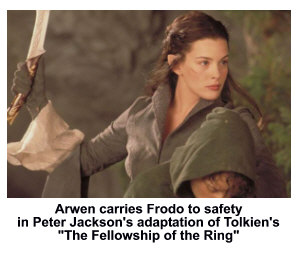 By the time the elf-princess Arwen arrives, Frodo has nearly become a wraith himself. In a beautiful, yet terrifying scene, she races against time, carrying him on her noble white horse toward Rivendell, the home of Elrond, the elf-lord and the only one with the skill to heal a wound caused by a Morgul blade. Charging through the woods and across the fields, clinging desperately to the hope of Frodo's healing, Arwen is pursued by the Nazgul, the screeching Ringwraiths, who are determined to see the hobbit descend into their world. The music reaches a fevered pitch as the shadowy wraiths grasp and claw at the wounded Frodo and the Ring he carries. But Arwen deftly guides her brave horse through the woods and plains and on to the river that shields Rivendell from all evil. By the time the elf-princess Arwen arrives, Frodo has nearly become a wraith himself. In a beautiful, yet terrifying scene, she races against time, carrying him on her noble white horse toward Rivendell, the home of Elrond, the elf-lord and the only one with the skill to heal a wound caused by a Morgul blade. Charging through the woods and across the fields, clinging desperately to the hope of Frodo's healing, Arwen is pursued by the Nazgul, the screeching Ringwraiths, who are determined to see the hobbit descend into their world. The music reaches a fevered pitch as the shadowy wraiths grasp and claw at the wounded Frodo and the Ring he carries. But Arwen deftly guides her brave horse through the woods and plains and on to the river that shields Rivendell from all evil.
Once she at last crosses the great river, Arwen turns toward the Nazgul. The wraiths pause at the water's edge, sensing that this place is a domain of good. The elf-princess then does something that few of us would have the nerve to consider. She actually challenges the dark hosts! With a voice like fire and with her sword drawn, she defies the pursuing darkness, saying, "If you want him, come and claim him!" Not used to being resisted, the Nazgul are momentarily taken aback. Finally, with their cold, cruel swords flashing and hearts full of malice, desperate to snatch Frodo and the Ring, they begin to cross the river. At that moment, Arwen utters ancient words in the elvish tongue, which causes the waters of the river to rise to a raging torrent, and the Ringwraiths are washed away in the mighty flow!
What a scene! If only there were opportunities in real life to take a stand against such evil and play the hero in some great adventure. Replaying this scene again and again in my mind, I began to draw some important connections.
What if the circumstances that unfolded in the lives of young people today are every bit as heroic and mythic as the events played out in The Fellowship of the Ring?
Think about it. Why do stories touch our hearts like nothing else can?
One reason is that life comes at us scene by scene, just like a story! We remember our lives in an almost chapter by chapter way, don't we? There was the fourth-grade chapter, the middle school chapter, the high school chapter, the college chapter, the first job chapter.... Yes, there is something about our lives that is very story-like!
I have been a middle school teacher for many years now. In that time, I have formed relationships with many students and had the opportunity to watch them grow and learn. I could tell stories that would leave you in stitches from laughing so hard! Other stories would bring tears. If we are honest with ourselves, we will admit that some of the trials that befell us during those school years would be things that we wish we could forget. Let's face it, growing up is hard!
We have all seen our share of heartache, harassment, the loss friendship, isolation, divorce, death, humiliation, and pressure-if not in our own story, then at least in the stories of our friends and loved ones. Some try to shrug it off, saying that this is all just a part of adolescence, and that the kids will "get over it." But many of you have witnessed these ordeals firsthand — and many have never gotten over it. The wounds they have endured in those years of life have stayed with them, like a cancer on the soul.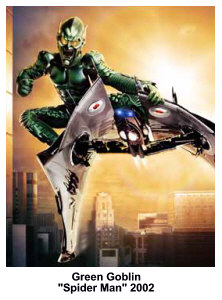 One man I was mentoring finally confessed to me after several months that the tormenting he endured in eighth grade at the hands of a few bullies has played a huge part in his current struggle with anger issues. One man I was mentoring finally confessed to me after several months that the tormenting he endured in eighth grade at the hands of a few bullies has played a huge part in his current struggle with anger issues.
As the diabolical Spider-Man (2002) movie villain the Green Goblin plotted the demise of the web-slinging hero, he cackled, "The cunning warrior attacks neither the body nor the mind. Attack the heart!" Look at your own life. Your heart has been wounded. Things that you did, or that were done to you, have shaped the person you are today.
Myth and the Heart
This generation of students has been given more privileges and opportunities than all previous generations combined. We have incorporated technology into the classroom and the home as never before, in an attempt to deliver educational material in a manner that is exciting and informative. In fact, my first book, E-Teaching: Creating Web Sites and Student Web Portfolios Using Microsoft Powerpoint (Technology and Its Application) , touted the educational benefits of using technology in the learning process. Technology is an invaluable asset when it comes to educating our youth-but we must realize that students need more than technology can offer. We are connected to other learners around the world through the Internet and various other forms of instant communication. The knowledge of all the ages that have preceded us is now at the fingertips of this generation of young people. Ultra-realistic movies and video games entertain them in every way possible. What more could they ask for? , touted the educational benefits of using technology in the learning process. Technology is an invaluable asset when it comes to educating our youth-but we must realize that students need more than technology can offer. We are connected to other learners around the world through the Internet and various other forms of instant communication. The knowledge of all the ages that have preceded us is now at the fingertips of this generation of young people. Ultra-realistic movies and video games entertain them in every way possible. What more could they ask for?
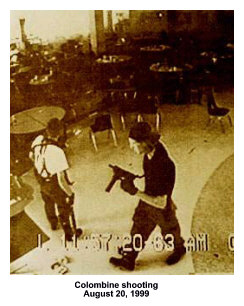 On August 20, 1999, two high school students walked into their school with loaded firearms and homemade explosives and began opening fire on their fellow Columbine High School classmates. Every day in this country, students drop out of school, get suspended, get into fights, try drugs, steal, cheat, lie to their parents, and betray friendships. We are losing them. Why? On August 20, 1999, two high school students walked into their school with loaded firearms and homemade explosives and began opening fire on their fellow Columbine High School classmates. Every day in this country, students drop out of school, get suspended, get into fights, try drugs, steal, cheat, lie to their parents, and betray friendships. We are losing them. Why?
What have we not given them? The answer is that we have not taken the time to connect with them at the level of the heart.
When the topic of the heart and soul comes up in a school meeting, too many teachers and other adult leaders say something to the effect of, "Whoa! I'm not going there." Those who work with students, especially public school teachers, have approached matters of the spirit with a great deal of trepidation.
We have been instructed to leave that area alone. However, if we see an insufficiency and our knee-jerk reaction is to say that it is not our responsibility to meet it, then we will reap the whirlwind in the days and years to come.
There does not need to be a national movement, nor a change in school policy; rather the current situation calls for a change in the policy of individual hearts toward young people. As George Bernard Shaw said, "Some men see things as they are and ask why. Others dream things that never were and ask why not." We need to finally admit that there is more to a student than simply their grades, friends, sports, and family. There is a heart, a spiritual core to every young person. We must "go there."
The world has changed quite a bit over the past few years. We are starting to view our young people in a new light. Realizing that the tests and challenges they face throughout the adolescent years are more than just things they will "get over," many have come to the conclusion that all who really care about today's youth need to view these challenges through a different lens. The lens that we need is myth and story.
If you read the lyrics of the song "Fortress Around Your Heart" by Sting, a modern-day bard, you will notice that viewing common situations through the light of myth can give us a remarkably different perspective. The song describes a relationship between a man and a woman that has grown cold. Love no longer exists. Under the ruins of a walled city . . . The man reflects on his past actions with regret, only now recognizing the pain that he caused his love. The siege guns had been pounding all through the night.
There was no real siege of a city. No army laying waste to the countryside or laying down barbed wire. Rather, this song was describing the devastation of a heart that had been crushed and wounded by another and the mission to recover something precious that had been lost. Instead of simply saying that this man recognized that he had hurt someone he cared deeply about and now understood that he needed to make amends, Sting portrayed the entire scenario in a mythical setting, a setting that helps to understand this event in a deeper and more meaningful manner.
Myths and stories help us to place the events of our lives in the proper perspective. Many of them have survived the vast millennia of human existence because they speak to us about the things that are true in life, the things that really matter, and the things that all people, regardless of time or culture, experience. The great stories that have moved us in a multitude of ways do so because they speak to us at the level of the heart.
This current generation has a wealth of "head knowledge." They know that light travels at 186,000 miles per second, and they can search the Internet to discover that Tahiti is the largest island in the Society Islands chain.
"Heart knowledge," however, is conspicuously absent in today's youth, and it is sadly reflective of our society as a whole.
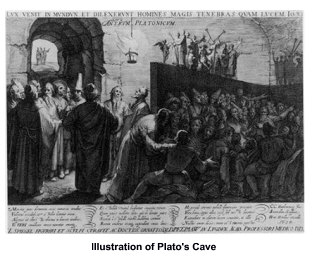 The great teachers throughout history have relied on stories to communicate something deeper, something that is impossible to communicate using mere facts and figures. Plato taught his students about encountering the unexplainable through a story that we refer to as Plato's Cave. He told the tale of a group of people who had been born into captivity, living the whole of their lives in a dark cave where the only source of light was a fire pit. Shadows danced on the walls of this cave, with the occupants having no awareness of the passing of day or night. All was the same. One day, one of the men who had spent his entire life in this cave escaped his subterranean confines and ventured outside to see the world. When he saw the brilliance of the sun in the blue sky, he fell to his knees in awe and reverence. Upon his return to the darkness of the cave, he tried to explain the wonderful sight he had witnessed on the surface. The man quickly became frustrated because no one was able to comprehend the beauty and power of the sun. The only thing they were able to understand was that the sun was like the fire pit. The great teachers throughout history have relied on stories to communicate something deeper, something that is impossible to communicate using mere facts and figures. Plato taught his students about encountering the unexplainable through a story that we refer to as Plato's Cave. He told the tale of a group of people who had been born into captivity, living the whole of their lives in a dark cave where the only source of light was a fire pit. Shadows danced on the walls of this cave, with the occupants having no awareness of the passing of day or night. All was the same. One day, one of the men who had spent his entire life in this cave escaped his subterranean confines and ventured outside to see the world. When he saw the brilliance of the sun in the blue sky, he fell to his knees in awe and reverence. Upon his return to the darkness of the cave, he tried to explain the wonderful sight he had witnessed on the surface. The man quickly became frustrated because no one was able to comprehend the beauty and power of the sun. The only thing they were able to understand was that the sun was like the fire pit.
Plato's students were aghast at the pitiful comparison of the glory of the sun to a mere fire pit. This story explains the challenge of such a mission with much greater authenticity than by simply saying that it is hard to explain something to someone who has not experienced it.
 Jesus taught his disciples through the use of parables, stories intended to convey a deeper truth about life. The parable of The Seeds and the Sower is, at least on the surface, a story about a farmer who scatters seeds across his land, with the seeds landing on various types of soil. Some seeds fall upon hardened, sun-baked soil, never getting a chance to germinate. Others land on fertile soil and take root; however, weeds eventually crowded out the young plants. But some of the seeds land on good soil, taking root and turning into full-grown plants. Jesus masterfully uses this story as a metaphor for the condition of a person's heart, their inner life. Jesus taught his disciples through the use of parables, stories intended to convey a deeper truth about life. The parable of The Seeds and the Sower is, at least on the surface, a story about a farmer who scatters seeds across his land, with the seeds landing on various types of soil. Some seeds fall upon hardened, sun-baked soil, never getting a chance to germinate. Others land on fertile soil and take root; however, weeds eventually crowded out the young plants. But some of the seeds land on good soil, taking root and turning into full-grown plants. Jesus masterfully uses this story as a metaphor for the condition of a person's heart, their inner life.
Stories speak to us in a way nothing else can. If we want to offer real hope and help to the young people in our spheres of influence, we must open our eyes and our hearts to the myths, fables, and stories of our youth-the stories that really mattered, that inspired us to be something greater. We will need them!
More than Meets the Eye
If the great stories have taught us anything, it is that there is more to reality than meets the eye. The Ugly Duckling is really a beautiful and powerful swan. The pathetic little girl who serves her stepsisters is seen by Prince Charming as the one person worthy to be his bride. Neo steps out of the Matrix, unveiling his true identity as "the One." The simple moisture-farmer Luke Skywalker leaves his planet of Tatooine and becomes a Jedi Knight.
And in real life, there is more-much more-to the young people we encounter than what the world sees on the outside.
Something else we can observe from myths is that the true, luminescent self cannot be released without help. The book of Genesis says that we were made in the image of God. However, it often takes the eyes of another to see beyond our exterior features, to see the greatness that we possess deep within.
 The Ugly Duckling would have never realized his noble heritage without the recognition of the other swans. Where would the Karate Kid have been without Mr. Miyagi? Morpheus believed in Neo, allowing him to have the confidence that he really was the One. Luke Skywalker was mentored by Obi-Wan Kenobi, and then trained by Yoda, before he could assume the mantle of Jedi Knight. The adolescents in our lives need us to fill the role of mentor, counselor, confidant, and friend. They need someone to believe in them, to see them mythically. They need someone to know that they have what it takes to be heroic in the tale that is being laid out before them. The Ugly Duckling would have never realized his noble heritage without the recognition of the other swans. Where would the Karate Kid have been without Mr. Miyagi? Morpheus believed in Neo, allowing him to have the confidence that he really was the One. Luke Skywalker was mentored by Obi-Wan Kenobi, and then trained by Yoda, before he could assume the mantle of Jedi Knight. The adolescents in our lives need us to fill the role of mentor, counselor, confidant, and friend. They need someone to believe in them, to see them mythically. They need someone to know that they have what it takes to be heroic in the tale that is being laid out before them.
Seeing Life as the Mythical Journey
The true self isn't discovered overnight; it's important to remember that. Nearly every myth puts forth the story of a character who goes on a journey or quest. The Greek hero Perseus went on a quest to slay the Gorgon Medusa before he could rescue the princess Andromeda. Alice tumbled down a rabbit hole into the mystery of Wonderland. Siegfried traversed the perils of Isenland to awaken the sleeping Valkyrie, Brunhild. 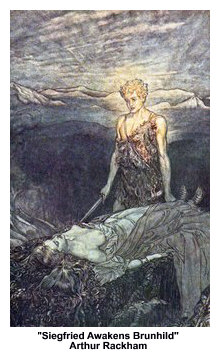 After a long journey to London, the young foster-child Arthur pulled the sword from the stone, revealing his true identity as the God-ordained King of All Britain. Frodo had to venture forth to destroy the Ring of Power in the fires of Mount Doom. The Sumerian hero Gilgamesh searched for the secret of immortality. Journeying toward a goal is an essential aspect of all myths and legends. After a long journey to London, the young foster-child Arthur pulled the sword from the stone, revealing his true identity as the God-ordained King of All Britain. Frodo had to venture forth to destroy the Ring of Power in the fires of Mount Doom. The Sumerian hero Gilgamesh searched for the secret of immortality. Journeying toward a goal is an essential aspect of all myths and legends.
Yet we are all on a journey of this magnitude, whether or not we wish to recognize it as such. We encounter event after event that is not of our making or of our own choosing: a baby is born, a loved one dies, your family needs to move to another state, your car stalls on a backcountry road .... Frame by frame, chapter by chapter, life plays out as a story.
Yes, dealing with such events is just part of being human. However, being human also involves the freedom to choose. One of the greatest tragedies in life is when we experience the journey of life, but ignore its meaning. If we choose to view our lives as anything less than a journey of mythical proportions, we will miss the true meaning behind our experiences. If we are to reach out to the next generation, we must first begin to open our eyes to the reality of the journey upon which we ourselves have embarked. We must see ourselves in a new light.
All heroes and heroines in myths and legends must first go on a journey, a journey that forces them to be more than they ever imagined they could be. It forces them to face their greatest fears, rather than avoiding them. It places them in situations that are uncomfortable and dangerous for the purpose of revealing their true capability. The quest at first appears to be disastrous, robbing them of life, but in the end, it is the journey itself that removes the veil from their hearts so that they can truly find life. If we want life, we must seek it out, fight for it.
The young people that we work with and love must be made aware of the importance of the journey, and that life is more than just random, meaningless events. They need to know that the journey is good, even if it is often painful. Their journey, their story, as Tolkien suggests, intersects with the stories of countless others, comprising the Great Story begun at the moment of Creation. We have an opportunity to intersect with and influence the journey of the young, and they will in turn add to our own story, and we will become better for it. They need to know that the journey will reveal their true identity, the person that the world so desperately needs them to be. We will begin to see this as well.
Jay D'Ambrosio, M.A. is an ancient history teacher and the author of Rethinking Adolescence: Using Story to Navigate Life's Uncharted Years (Rowman & Littlefield Education, 2006), as well as "Egyptian Influence on Early Israelite Literature" (Aeon: A Journal of Myth, Science, and Ancient History, 2005). You can learn more about this topic by visiting Jay's blog at eteaching101.blogspot.com.
Rethinking Adolescence: Using Story to Navigate Life's Uncharted Years
E-Teaching: Creating Web Sites and Student Web Portfolios Using Microsoft Powerpoint (Technology and Its Application)
Read more articles in Mythic Passages by Jay D'Ambrosio
Photos depicted from films are reproduced for Fair Use by a non-profit educational organization under the following terms:
- The photo is only being used for informational purposes,
- Its inclusion in the article adds significantly to the article because it shows the subject of this article,
- It does not limit the copyright owners rights to sell the original product in any way.
Return to Mythic Passages Menu
Subscribe to the Mythic Passages e-zine
|
